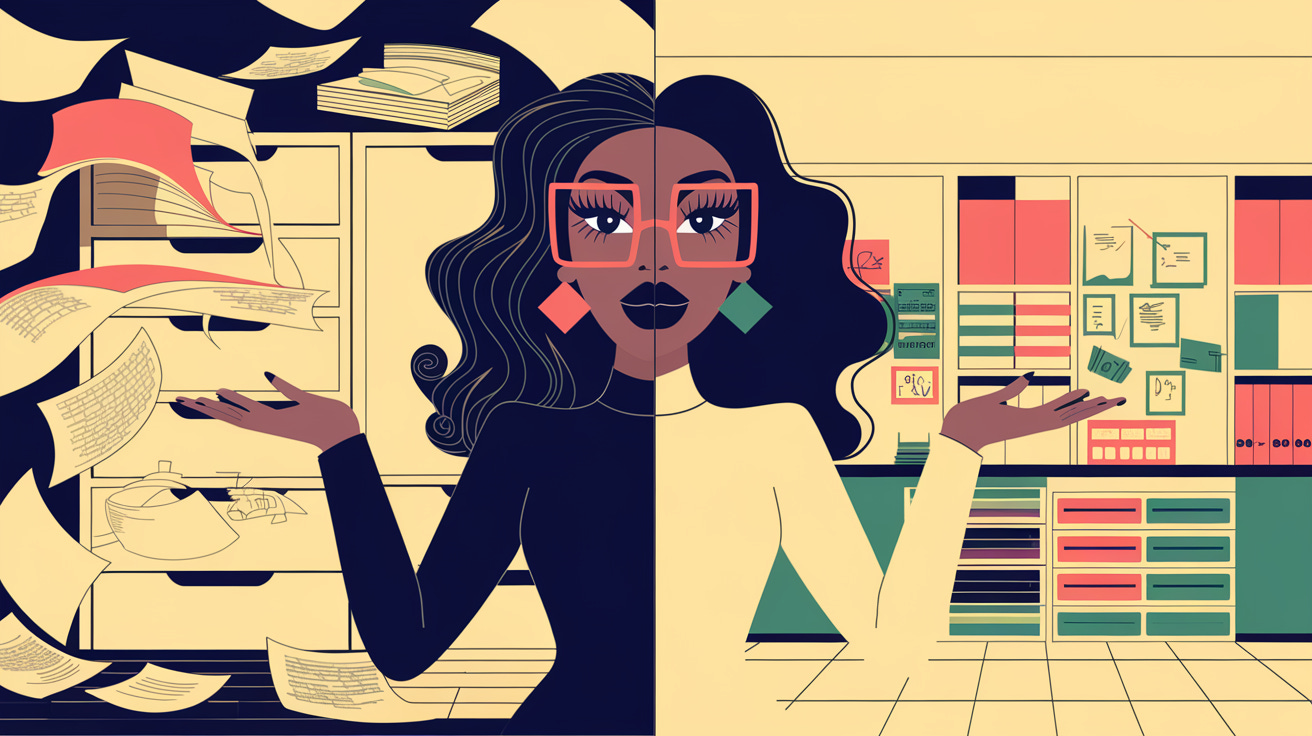The project management trick messy people swear by
No fancy tools, no big expenses - just a practical framework that works for chaotic minds.
“I’m just not one of those 'organized' people.”
I said this often, as though it justified the shoes piled at the door or my constant scramble to meet deadlines. It became my go-to excuse whenever life felt out of control. But deep down, I knew better. If I wanted to grow a side hustle while working a full-time job, I couldn’t hide behind that excuse any longer.
I needed change. I just didn’t know where to start - until I picked up the book ‘Clutterbug’.
This book shifted my perspective in ways I didn’t expect. A short quiz pinpointed my core issue: if something’s out of sight, it’s out of mind for me. My old systems relied on drawers, hidden compartments, and neatly categorized files. They were doomed to fail because they clashed with how my brain operates.
Suddenly, everything clicked.
I wasn’t a lost cause or hopelessly disorganized. I had simply been trying to use the wrong tools. My systems were rigid, overly focused on perfection, and far too impractical.
With these insights, I rebuilt everything.
I replaced drawers with open shelves. Neat, tucked-away files were swapped for organized piles in plain view. Rigid schedules gave way to plans with built-in flexibility. Practically overnight, staying organized became less of a battle and more of a natural flow.
That same shift transformed how I manage my side hustle.
For years, I forced myself into productivity systems that didn’t align with my messy, creative tendencies. I downloaded apps that buried tasks behind sleek menus and stuck to routines with zero room for spontaneity. Every time I failed to keep up, I blamed myself.
But when I stopped fighting my natural flow, I created a system that worked for me. I stopped hitting walls, wasting time, and feeling overwhelmed. That single change made all the difference.
Did you know that people who personalize their productivity systems are 35% more likely to stick to them and meet their goals?
Most advice assumes there’s a single “right way” to be productive. You’ve heard it before - “wake up at 5 a.m.” or “plan every minute of your day.” These approaches might work for some, but if they don’t fit how your brain operates, they’re worse than useless.
When you force yourself into systems that don’t suit you, you create friction.
You’ll avoid using those systems, and they’ll inevitably fall apart when life starts life'n. The truth is, the best system isn’t the sleekest or the most rigid - it’s the one you can consistently use without resistance.
Once I understood this, everything shifted. I wasn’t failing at being organized - I was failing to create systems that fit how I think and work.
Here’s how to use my P.I.L.E. Framework to help messy, creative minds like yours and mine stay organized and productive - without feeling boxed in:
P – Prioritize visually: Use tools that let you see your tasks, like Kanban boards, sticky notes, or color-coded lists.
I – Identify your “must-do” tasks daily: Focus on the top 3-5 tasks that move the needle, not the busywork.
L – Leave space for flexibility: Build systems that can handle change, like batching tasks or setting blocks of time instead of rigid schedules.
E – Evaluate weekly: Check in on what’s working and tweak it, rather than waiting until chaos takes over.
Why This Works
Tailoring your system to your natural tendencies removes unnecessary resistance.
For instance, if you’re a visual thinker like me, tools such as whiteboards or Kanban boards will outperform apps that hide tasks in endless dropdowns.
Simplicity is key.
The more frictionless your system, the easier it is to stick with - and the less time you’ll spend deciding what to do next. That leaves your energy free for the creative work you actually enjoy.
Most importantly, this approach is sustainable. Anyone can follow a rigid system for a week or two, but long-term success depends on something you can maintain for the long run.
Here’s What You’ll Get Out of It
More time for what matters: By reducing friction, you free up hours for meaningful work.
Less stress and chaos: A personalized approach makes staying organized feel effortless.
Confidence in your progress: With clear priorities and a system that fits, you’ll feel in control of your 9-5, your side hustle, and your life.
“The best system is the one that works for you - messy or not.”
Your Turn
Take an honest look at how you manage your tasks and projects. Are you constantly scrambling to keep up? Using tools you don’t enjoy? Sticking to routines that feel unnatural?
If the answer is yes, it’s time to stop forcing yourself into systems that don’t work.
Start small. Identify one area where you’re struggling - task management, scheduling, or staying motivated. Pick one step from the P.I.L.E. Framework to try today.
Maybe it’s switching to a Kanban board, narrowing your daily priorities, or building flexibility into your plans.
Experiment. Evaluate. Adjust.
The beauty of this approach lies in its adaptability. It’s a system that grows with you and makes space for consistent progress - no matter what you’re working on.



